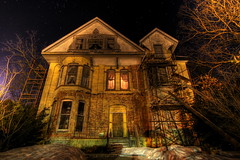Sometimes a setting is so vivid and so involved in the plot—sometimes even becoming an antagonist—that we say the setting is a character in the story. And that’s actually very close to what I think is the truth. No, settings are probably not going to be as dynamic or as influential to a story as your characters will be—but it’s the characters that make the setting.
Last time, I mentioned The Cruelest Month by Louise Penny, and a haunted house setting she uses. She sets up some facts and background: people had been murdered there, it stood vacant, they were about to hold a séance there. But those facts aren’t enough to create the chilling haunted house she’s going for.
 It’s more than just empirical facts that imbue a setting with a sense of place or make it come to life. Penny also uses emotion to flesh out her settings. To paraphrase characters in The Cruelest Month, this house
It’s more than just empirical facts that imbue a setting with a sense of place or make it come to life. Penny also uses emotion to flesh out her settings. To paraphrase characters in The Cruelest Month, this house
- is the focus of local evil and ill-will, offsetting the good spirits of the bucolic, idyllic village
- inspires dread
- has a powerful draw on the characters, despite their dread
- is the perfect setting for an effort to raise the dead
- um, is a murder scene. and abandoned. (because the facts do help a little
.)
Describing a decrepit old house won’t be enough to inspire a specific response from your characters or your readers. Powerful settings actually have less to do with the location itself, and more to do with the psychological and emotional effect these places have on the characters. As writers, we can almost always access our readers’ emotions best by using our characters’ emotions. Settings won’t have an impact on the reader if they’re not having an impact on the characters.
Tapping into character’s emotions allows us to connect with our readers. In some ways, the setting’s best use can be to create those emotions and set the mood for a scene, drawing your readers in by inspiring those same feelings in them as they see the setting through our characters’ eyes.
What do you think? How else can setting connect with readers’ emotions?
Photo by Shane Gorski


That’s one of the things I do when I analyze my writing. I try to determine the “mood” of a scene.
Light, dark, open, closed, etc. Sometimes I want it to echo the sentiments of a scene (a dark and stormy night) or contrast it (a murder during a festive wedding).
But sometimes I think that settings do too much. I had a dinner scene that I thought be more effective somewhere besides a dinner table, somewhere a bit more exciting, but then I realized sometimes people just have dinner, and the setting just needs to go away.
I agree that settings can distract. I read a book recently where it seemed like the author was trying to force the city to be a character. I didn’t buy it and couldn’t finish the book.
> Settings won’t have an impact on the reader if they’re not having an impact on the characters.
I had an ah-ha moment tonight! I’ve been groping toward this realization, but I couldn’t put it in words before now. Thanks!
What a compliment! I wish I could say I realized this while writing, but it shows why we must always be reading.